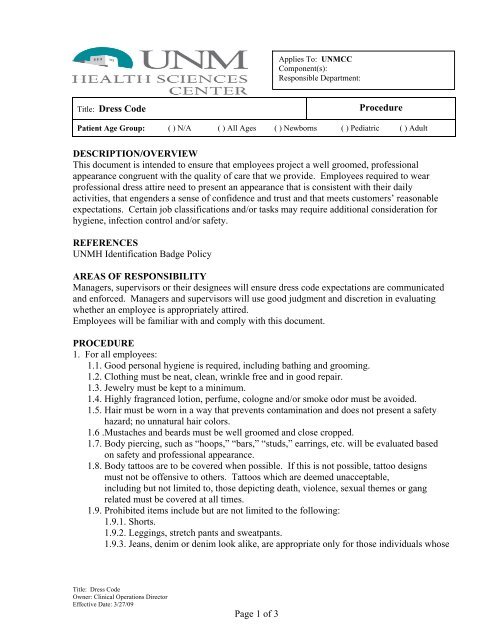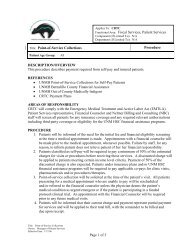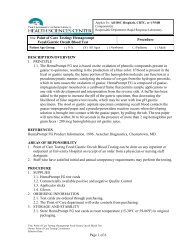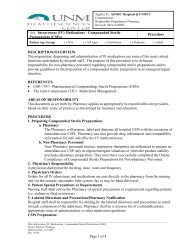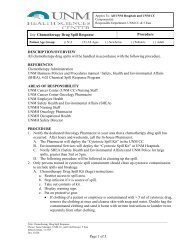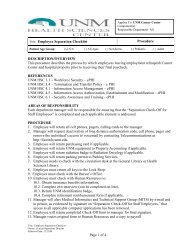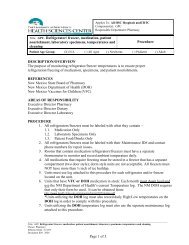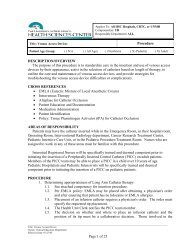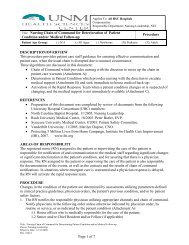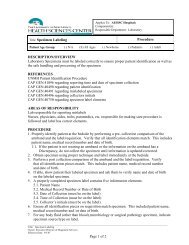Title: Dress Code Procedure DESCRIPTION/OVERVIEW This ...
Title: Dress Code Procedure DESCRIPTION/OVERVIEW This ...
Title: Dress Code Procedure DESCRIPTION/OVERVIEW This ...
You also want an ePaper? Increase the reach of your titles
YUMPU automatically turns print PDFs into web optimized ePapers that Google loves.
Applies To: UNMCCComponent(s):Responsible Department:<strong>Title</strong>: <strong>Dress</strong> <strong>Code</strong><strong>Procedure</strong>Patient Age Group: ( ) N/A ( ) All Ages ( ) Newborns ( ) Pediatric ( ) Adult<strong>DESCRIPTION</strong>/<strong>OVERVIEW</strong><strong>This</strong> document is intended to ensure that employees project a well groomed, professionalappearance congruent with the quality of care that we provide. Employees required to wearprofessional dress attire need to present an appearance that is consistent with their dailyactivities, that engenders a sense of confidence and trust and that meets customers’ reasonableexpectations. Certain job classifications and/or tasks may require additional consideration forhygiene, infection control and/or safety.REFERENCESUNMH Identification Badge PolicyAREAS OF RESPONSIBILITYManagers, supervisors or their designees will ensure dress code expectations are communicatedand enforced. Managers and supervisors will use good judgment and discretion in evaluatingwhether an employee is appropriately attired.Employees will be familiar with and comply with this document.PROCEDURE1. For all employees:1.1. Good personal hygiene is required, including bathing and grooming.1.2. Clothing must be neat, clean, wrinkle free and in good repair.1.3. Jewelry must be kept to a minimum.1.4. Highly fragranced lotion, perfume, cologne and/or smoke odor must be avoided.1.5. Hair must be worn in a way that prevents contamination and does not present a safetyhazard; no unnatural hair colors.1.6 .Mustaches and beards must be well groomed and close cropped.1.7. Body piercing, such as “hoops,” “bars,” “studs,” earrings, etc. will be evaluated basedon safety and professional appearance.1.8. Body tattoos are to be covered when possible. If this is not possible, tattoo designsmust not be offensive to others. Tattoos which are deemed unacceptable,including but not limited to, those depicting death, violence, sexual themes or gangrelated must be covered at all times.1.9. Prohibited items include but are not limited to the following:1.9.1. Shorts.1.9.2. Leggings, stretch pants and sweatpants.1.9.3. Jeans, denim or denim look alike, are appropriate only for those individuals whose<strong>Title</strong>: <strong>Dress</strong> <strong>Code</strong>Owner: Clinical Operations DirectorEffective Date: 3/27/09Page 1 of 3
jobs may demand this type of apparel (maintenance, laboratory, etc.). Fadedjeans, acid washed jeans, athletic attire or bib overalls are not appropriate foranyone.1.9.4. Sweatshirts or T-shirts with logos.1.9.5. Tank or tube tops, halter tops, tops with spaghetti straps, strapless tops or dresses.1.9.6. Any tight, low cut or sheer clothing or any attire that exposes skin between the topand bottom layer of clothing.1.9.7. Skirt/dress length and/or tops of slits cannot be shorter than half way betweenthe top of the knee and mid-thigh.1.9.8. Flip flop sandals.1.9.9. Headwear, unless an employee works outside, is required for safety, is required formedical reasons or is associated with religious beliefs.2. For positions involving direct patient care:2.1. Footwear should be safe, supportive, clean and non-noise producing; no open-toe shoes.2.2. Artificial nails are prohibited; natural nails must be kept short (no longer than ¼ inchbeyond the fingertip) and clean.2.3. Preferable attire for mid-levels includes a white lab coat provided by the Cancer Center.2.4. Clinical staff, such as RNs, MAs, surgical technicians must wear scrubs.3. For clerical or business positions not involving direct patient contact:3.1. Business casual dress is appropriate for clerical and business employees. For men, thisincludes pants and long or short sleeve dress shirt, collared knit (Polo) or sport shirt.For women, this includes dresses, skirts (see 1.9.7.), slacks and blouses or sweaters.Hosiery may be optional, as determined by the manager and based upon the degree ofcontact with the public.3.2. In areas where nail polish can be worn, it must be in neat condition and businessappropriate in color and design.4. For positions involving research lab work:4.1. It is the responsibility of the Associate Director, Basic Research to establish appropriatedress standards for the personnel assigned to UNMCC research laboratories.These standards will be in accordance with all applicable hygiene and safetyrequirements.5. Uniforms5.1. Certain areas may require specified uniforms (insignia shirts, smocks, lab coats, scrubs,etc.). Employees are encouraged to discuss this with their supervisor.5.2. If uniforms are required and furnished by UNMCC, employees will be required to weartheir uniforms on the job and assume full responsibility for their cleanliness andmaintenance. Items will be replaced based on normal wear and tear.6. Identification - the employee identification badge must be displaced above the waist line atall times while on duty. Extraneous pins or decals are not to be placed on the front of thebadge. Neither the employee name nor the employee photo on the badge is to be obscured.7. Exceptions:7.1. If the temperature cannot be controlled due to HVAC equipment malfunction, employeesmay be allowed to temporarily wear jackets, blazers, sweaters or other items, providedthe overall appearance of the team presents an acceptable image as determined solely byclinic or department manager. Name tags must always be visible.7.2. Any other exception, such as religious or faith-related clothing, or when an individualmust wear prescribed clothing as a result of an ADA disability, is at the sole judgment of<strong>Title</strong>: <strong>Dress</strong> <strong>Code</strong>Owner: Clinical Operations DirectorEffective Date: 3/27/09Page 2 of 3
clinic or departments manager, with consultation with the Human Resources7.3. It may be necessary or helpful to expand or modify these general guidelines incertain departments in order to meet special or diverse needs of each facility. If thereare questions relating to this procedure, they should be directed to Human Resources.7.4. Senior Leadership may authorize exceptions to this dress code for special daysor events or to meet specific needs of the department.DEFINITIONSDirect Patient Care – includes Nurses, Medical Assistants, Surgical TechniciansClerical or Business – includes Patient Services staff, Medical Records staff,Administrative Assistants and Patient Navigator staffProfessional – Administrators, Managers, Supervisors, Support Staff and Licensed AncillaryCare staff who routinely work in clinical and/or administrative areas and who have patient-careinteractions and/or interactions with the public, community representatives and other HSCofficialsSUMMARY OF CHANGESNewRESOURCES/TRAININGResource/DeptIndividual Department DirectorsInternet/LinkDOCUMENT APPROVAL & TRACKINGItem Contact Date ApprovalOwnerClinical Operations DirectorConsultant(s)Committee(s)Max Beck, Senior Human Resources ConsultantUNMCC PP&G CommitteeUNMCC Clinical Operations GroupNursing Director Sandi Peacock, MBA, BSN, RN YMedical Director Ian Rabinowitz, MD YHuman Resources Max Beck YFinance Brad Mucek, CFO YLegalOfficial Approver Don Whitehead, COO YOfficial SignatureApprover (Optional)SignatureEffective Date 3/27/09Origination DateY<strong>Title</strong>: <strong>Dress</strong> <strong>Code</strong>Owner: Clinical Operations DirectorEffective Date: 3/27/09Page 3 of 3


